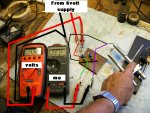rog8811 said:@ DDL I have built the power supply to your design...except that my VR is 200ohm and the series res is 4.4ohm.
When I power it with 6 volts it lights an led, at lowest setting, with a measured output of 4.63v @ 6.5ma
turning the pot to other end of scale... the led doesn't appear to get brighter and I measure 5.84v @ 36ma
Does any of that look right?
Regards rog8811
Just thought I am using a 1n4148 diode, but that should only effect things on reverse polarity.
First off, glad you got the parts and the VR and the R-block (as I like to call it), sound perfectly fine. I assume you know the max possible by the circuit with a 4.4-Ohm, it's about 284mA.
I would check 2 things... First of all make sure you have plugged the LM317 in right, that you plugged things into it right, and that you didn't mix up the Vout and the Adj poles. (remember that on the LM317T the big heat sink is linked to the Vout, and you can connect using it.) Second, try to take everything out, the LED's the 1N4148 and anything past the point where the Adj and the Vout lines meet (after the VR and R-block) and connect a DMM in there to make sure the circuit is wired right. Simply connect the red DMM pole to the junction and the Black pole to ground. If you see current flowing through then your connection is right, otherwise then you have wired the LM317 the wrong way or you have a dead LM317.
Hope this helps;
DDL






